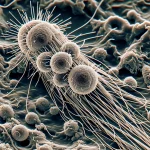Here is a quick way to identify macro-nutrient deficiency and toxicity symptoms
NITROGEN
Toxicity Symptoms
- Plants are dark green in colour with excessive amount of foliage
- Root growth is restricted
- Reduced flowering and seed production
- Plants wilt quickly under water stress situations
- Susceptible to diseases.
Deficiency Symptoms
- Plants are light green in colour starting at the bottom leaves
- Restricted growth
- Leaves are smaller than normal
- Purple discolouration at the underside of the leaves.
PHOSPHORUS
Toxicity Symptoms
- Older leaves turn yellow
- Older leaf tips turn yellow or brown followed by necrotic spots
- Leaf abscission
- Mature leaves may look crushed or wrinkled
- Dry spots appear on leaves and fruits
- Look for iron precipitate during high P applications especially at low pH
- Remember Cu and Zn deficiency may appear as P toxicity, don’t be confused
Deficiency Symptoms
- P is mobile in the plant so deficiency appears first in lower mature leaves
- Plants are stunted, very dark green in colour with narrow petiole angles
- Large amount of reddish or purple pigmentation
- Leaves may turn purple to black in colour
- Chlorosis found on older leaves
- Roots are yellow to brown in colour
- Stems are slender and growth point is affected
POTASSIUM
Toxicity Symptoms
- Seldom occurs since K absorption is active process
- High K will cause interaction with Mg, Mn, Zn and Fe resulting in deficiency symptoms of these elements
Deficiency Symptoms
- Symptoms occur first in lower leaves since the elements is very mobile
- Deficiency symptoms may occur where the growth media has a very high negative charge resulting in K being fixed to the medium
- K deficiency symptoms vary according to plant species
- Plants are generally weak and has low resistance to disease
- Plants react quickly to water deficiency and wilt during hot days
- Many plants show necrosis of the leaf tips initially and later between veins
- Young leaves slightly darker than the rest
- Leaves are small and plants are stunted
- Fruit are soft and puffy and have short shelf life
- Uneven ripening occurs
- Stalks are slender
- Quick remedy: spray with a 2% potassium sulphate solution.
CALCIUM
Toxicity Symptoms
- Excess Ca will be expressed as excess Fe, K or magnesium
- The plant has a high tolerance of high concentrations of Ca in the nutrient solution
Deficiency Symptoms
- Hardly ever occurs as a pure deficiency since most fertilizers contain some form of Ca in order to bind various elements
- Calcium is absorbed at the root tip and any condition that restricts root growth will restrict Ca uptake
- Deficiency symptoms are blossom end rot on tomatoes, peppers and brinjals, which is mostly and induced deficiency during conditions of high temperatures and low humidity
- Tip burn on lettuce leaves which is mostly and induced deficiency during conditions of high temperatures and low humidity
- Once the deficiency symptom has been noticed it is to late to correct the problem
MAGNESIUM
Toxicity Symptoms
Magnesium deficiency do not occur, however, very high Mg concentrations will result in the deficiency symptom of another cation.
Deficiency Symptoms
- Mg is very mobile so the first signs of deficiency will be seen on the older leaves.
- First symptoms are interveinal chlorosis
- Moderate deficiencies result in all leaves being lighter in colour
- Induced deficiencies due to high concentrations of ammonia NH4, K and Ca
- Some plants show orange discolouration on the tips of leaves
- Mg deficiency is quite often confused with Mn deficiency. Remember Mg starts at the lower leaves while Mn starts at the upper leaves.
- Mg deficiency will result in very little reduction in yields
- Tomatoes are very sensitive to Mg deficiencies
- Symptoms on leaf start as interveinal chlorosis close to the midrib and major veins of leaves.
- The spots extend outwards in regular patterns
- The affected areas become necrotic and coalesce into larger scorched areas
- Leaves are usually pale green and have a bleached appearance
SULFUR
Toxicity Symptoms
- Plants can tolerate high concentrations of S
- Reports have shown that some plants will survive levels of 600ppm in solution
- Plants show a bluish green colour of leaves
- Leaf and stem become hard
- Leaf may curl inward and become pimpled similar to oedema.
- Extreme toxicity levels in solution results in browning of leaf margins and terminal growth becomes pale and yellow
- S is antagonistic towards Ca and high S levels may induce Ca deficiency
Deficiency Symptoms
- Nitrogen problems are quite often confused with S deficiencies since these two elements have a close relationship in the various processes in the plant
- The S symptoms are slow to develop and resemble N deficiency
- First symptoms are in lower leaves where chlorosis appears
- Young leaves are also very susceptible
- The internodes are longer than normal and older leaves may be thicker than younger leaves.



